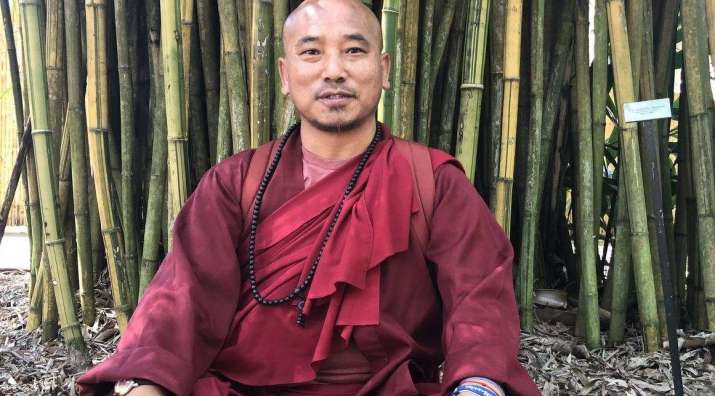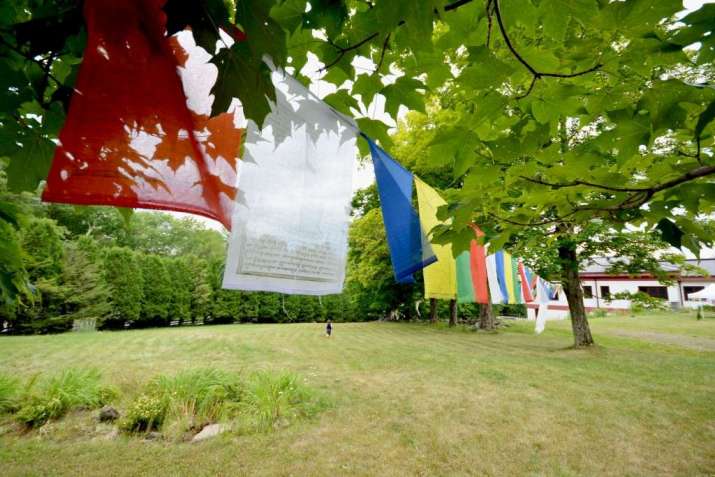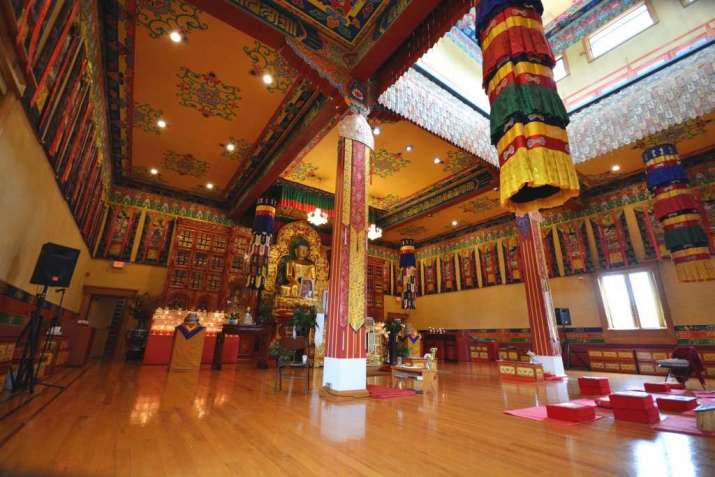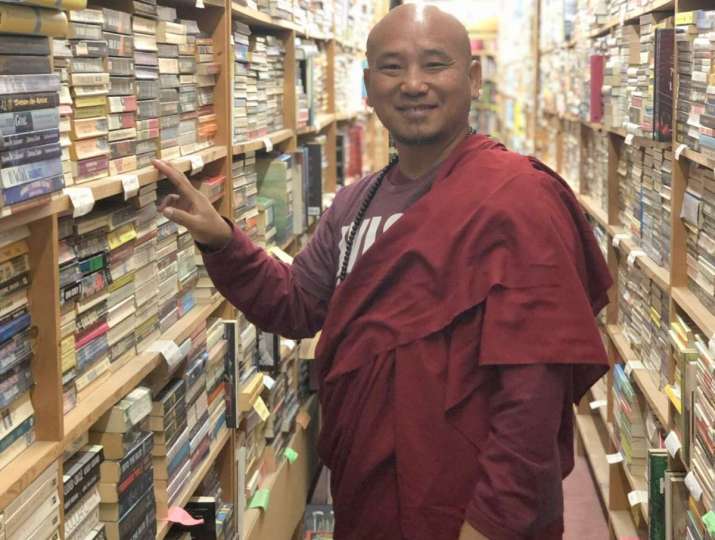FEATURES|THEMES|People and Personalities
Insight on Practice for Beginners with Khenpo Karma Tenkyong
 Khenpo Karma Tenkyong. Photo by Karma Gyatsho
Khenpo Karma Tenkyong. Photo by Karma GyatshoNestled in the hilly outskirts of Woodstock, New York, is Karma Triyana Dharmachakra, the North American seat of His Holiness the Gyalwang Karmapa where Khenpo Karma Tenkyong has served as resident teacher since 2014 and as president from 2015–18. Known for his dynamism and passion in conveying the Dharma, Khenpo also expresses great reverence for the environment through his activities and teachings.
Buddhistdoor Global interviewed Khenpo Tenkyong this month on various aspects of Buddhist practice for beginningers, including notes on cultivating wisdom to understand the nature of emotion, the need for meditation in the 21st century, and more.
Buddhistdoor Global: I am a beginner meditator and beginning to pay attention to my emotions from another perspective. I have always known that some emotions, such as anger, can be very disruptive, and I appreciate the way that practice and meditation can help one look at anger and aggression from another perspective. What are your suggestions for those who come to Buddhism looking to work further on these disruptive qualities of emotion?
Khenpo Karma Tenkyong: In my experience, for beginners interested in Buddhist practice there are three types of wisdom which can help us with disruptive emotions: wisdom from listening to teachings, wisdom from contemplating, and wisdom from practice.
 Karma Triyana Dharmachakra yard and prayer flags. Photo by Annika Lundkvist
Karma Triyana Dharmachakra yard and prayer flags. Photo by Annika LundkvistFrom listening to and gathering wisdom from teachings, we come to realize that we have to learn and understand the meaning and background of emotions such as anger and aggression. From this understanding we can gain a very clear wisdom. We understand that anger and aggression not only hurt others, but also hurts us! Every moment we engage with life through anger and aggression, we are killing ourselves. And we realize that when we give space to emotions like anger, we give up space that we can have for loving-kindness.
With this wisdom, we can gain even more realization through wisdom from contemplation. When we contemplate the teachings and texts even further, we can find within ourselves and the texts the pure and right reasons for why these emotions arise within us and why and how we can change. Through contemplation, this is possible.
These two wisdoms by themselves are not enough, however. Finally, we have to use these wisdoms in our practice, in our daily life. Once we have understanding, we must act and begin to make small changes at first. This is one way to deal with disruptive emotions.
Another way we can work with these emotions is by learning and practicing how to take out or drop disruptive emotions scuh as hatred, aggression, and anger. For this practice, we have to join a meditation course to learn this style.
 Meditation hall in Karma Triyana Dharmachakra. Photo by Annika Lundkvist
Meditation hall in Karma Triyana Dharmachakra. Photo by Annika LundkvistBDG: One thing that attracts me to meditation is the possibility for reducing the “busy-ness” of the mind. To learn to be more at peace, more focused, and less distracted. What are some of your observations about the relationship of practice and the “busy mind?”
KKT: From my experience, we really need meditation practice in this century, right now. The 21st century and meditation need to be good friends. Meditation is the main antidote for this time, I feel.
One good thing is that we can improve our awareness from the “busy-ness” mind of our time. This is actually very beautiful. This 21st century is the best time to undertake mind-training practice. Our busy minds help to develop our awareness of our mind and body. Moreover, if we practice shamatha (calm-abiding) meditation, this will really help in our situation. We have to give a good job—the right job—to our busy minds.
 Khenpo Karma Tenkyong. Photo by Karma Gyatsho
Khenpo Karma Tenkyong. Photo by Karma GyatshoBDG: You have an extensive background in scholarship and teaching. What is your advice for individuals who may not have an active sangha nearby, but who want to enrich their lives with more practice and Buddhist study.
KKT: For those who do not have an active group nearby, but wish to study and practice, I think there are four good steps to help develop your practice and your mind: first, using your wisdom power of contemplation, contemplate the purpose of your precious life. Next, using your wisdom power of contemplation, find the value of time. Third, practice meditation formally. Make your meditation practice a priority and not informal. Practice every day for at least 21 minutes. Fourth and last, every season, plan to attend a retreat (even just a weekend!) with any good lineage teacher.
BDG: I have read about your love for the natural world and for protecting the environment. What are your thoughts about our modern-day relationship with our environment? What are some of your thoughts about our individual and collective responsibility to, and connection with, the natural world?
KKT: In the modern day, forming a good and deep relationship with the environment is the best foundation for any lasting practice. We can practice giving our loving-kindness practice to all living beings through loving-kindness to Mother Earth. This is really the best subject and practice!
As for our responsibility to the Earth and to each other, in my experience, we can first practice less desire. To do this, we should check with our mind: do we need or do we want? This is a simple check for ourselves that can have lasting results for both our beautiful world and our minds.
BDG: I have also read that you are very interested in the vegan lifestyle. I am a vegan myself and it would be wonderful to enjoy a meal together one day! What do you enjoy eating in your region?
KKT: Yes, of course! If you can, Woodstock has a wonderful, fresh, and vegan restaurant called Garden Cafe. I’d love to eat there with you when you have time and when you come to visit. Or if we can meet in New York City, we can eat at other vegan restaurants such as Red Bamboo or Buddha Bodai. Practicing the vegan lifestyle is like giving the best healing handshake to all animals and our environment. I am still learning the vegan lifestyle.
Annika Lundkvist is a photographer and writer from the United States currently based in Scandinavia. She became interested in the Buddhist teachings, architecture, and space after a road trip in 1999 to Nechung Dorje Drayang Ling (Wood Valley Temple) on Big Island (Hawaii). She has previously researched and written on Vajrayana design and space in New York State and seeks to explore and document more Buddhist architecture and design. She is also exploring the lessons and challenges of combining Buddhism and parenthood, including the often humorous but precarious balance of mothering young children and creating time for practice. As a writer and photographer, Annika is committed to using her crafts to contribute to the expanding field of Buddhist journalism. Her monkey mind is still in training.
Related features from Buddhistdoor Global
The Mindful Scroll
Bringing Awareness Practice from Retreat into the World
Debunking the Myth of Meditation
Exclusive Interview: The 17th Karmapa and the Buddhist Nuns of the Tibetan tradition














